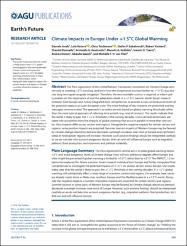| dc.contributor.author | Jacob, Daniela | |
| dc.contributor.author | Kotova, Lola | |
| dc.contributor.author | Teichmann, Claas | |
| dc.contributor.author | Sobolowski, Stefan P. | |
| dc.contributor.author | Vautard, Robert | |
| dc.contributor.author | Donnelly, Chantal | |
| dc.contributor.author | Koutroulis, Aristeidis G. | |
| dc.contributor.author | Grillakis, Manolis G. | |
| dc.contributor.author | Tsanis, Ioannis K. | |
| dc.contributor.author | Damm, Andrea | |
| dc.contributor.author | Sakallı, Abdulla | |
| dc.contributor.author | van Vliet, Michelle T. H. | |
| dc.date.accessioned | 12.07.201910:50:10 | |
| dc.date.accessioned | 2019-07-12T22:06:16Z | |
| dc.date.available | 12.07.201910:50:10 | |
| dc.date.available | 2019-07-12T22:06:16Z | |
| dc.date.issued | 2018 | |
| dc.identifier.citation | Jacob, D., Kotova, L., Teichmann, C., (...), Sakalli, A., van Vliet, M.T.H. (2018). Climate impacts in Europe under+1.5 degrees C global warming. Earth's Future, 6(2), 264-285. doi: 10.1002/2017EF000710 | en_US |
| dc.identifier.issn | 2328-4277 | |
| dc.identifier.uri | https://doi.org/10.1002/2017EF000710 | |
| dc.identifier.uri | https://hdl.handle.net/20.500.12508/681 | |
| dc.description | WOS: 000427563600009 | en_US |
| dc.description | Science Citation Index Expanded | en_US |
| dc.description.abstract | The Paris Agreement of the United Nations Framework Convention on Climate Change aims not only at avoiding +2 degrees C warming (and even limit the temperature increase further to +1.5 degrees C), but also sets long-term goals to guide mitigation. Therefore, the best available science is required to inform policymakers on the importance of and the adaptation needs in a +1.5 degrees C warmer world. Seven research institutes from Europe and Turkey integrated their competencies to provide a cross-sectoral assessment of the potential impacts at a pan-European scale. The initial findings of this initiative are presented and key messages communicated. The approach is to select periods based on global warming thresholds rather than the more typical approach of selecting time periods (e.g., end of century). The results indicate that the world is likely to pass the +1.5 degrees C threshold in the coming decades. Cross-sectoral dimensions are taken into account to show the impacts of global warming that occur in parallel in more than one sector. Also, impacts differ across sectors and regions. Alongside the negative impacts for certain sectors and regions, some positive impacts are projected. Summer tourism in parts of Western Europe may be favored by climate change; electricity demand decreases outweigh increases over most of Europe and catchment yields in hydropower regions will increase. However, such positive findings should be interpreted carefully as we do not take into account exogenous factors that can and will influence Europe such as migration patterns, food production, and economic and political instability. | en_US |
| dc.description.sponsorship | European Union [282746]; Niels Stensen Fellowship; Veni-grant of NWO Earth and Life Sciences [863.14.008]; RCN [255397] | en_US |
| dc.description.sponsorship | We are grateful to use the data which were obtained during the course of work of the project IMPACT2C: Quantifying projected impacts under 2 degrees C warming. IMPACT2C has received funding from the European Union Seventh Framework Programme FP7/2007-2013 under grant agreement no 282746. These data were obtained freely from the IMPACT2C data archive (impact2c.dmi.dk). Dr. Michelle van Vliet was financially supported by a contribution of Niels Stensen Fellowship and a Veni-grant (project 863.14.008) of NWO Earth and Life Sciences (ALW). SPS is partially supported by RCN grant no. 255397. We would like to thank David Williams for his valuable support. The authors would like to thank two anonymous reviewers for their constructive comments and helpful suggestions that have contributed to improve this article. | en_US |
| dc.language.iso | eng | en_US |
| dc.publisher | John Wiley and Sons Inc | en_US |
| dc.relation.isversionof | 10.1002/2017EF000710 | en_US |
| dc.rights | info:eu-repo/semantics/openAccess | en_US |
| dc.subject | Climate Change | en_US |
| dc.subject | Climate Change Impacts | en_US |
| dc.subject | +1.5oC and+2oC Global Warming | en_US |
| dc.subject | Europe | en_US |
| dc.subject | IMPACT2C Project | en_US |
| dc.subject.classification | Environmental Sciences | Geosciences, Multidisciplinary | Meteorology & Atmospheric Sciences | en_US |
| dc.subject.classification | Climate | Climate change | Negative emissions | en_US |
| dc.subject.other | 1.5 degrees-c | en_US |
| dc.subject.other | temperature | en_US |
| dc.subject.other | circulation | en_US |
| dc.subject.other | summer | en_US |
| dc.subject.other | model | en_US |
| dc.subject.other | variability | en_US |
| dc.subject.other | patterns | en_US |
| dc.subject.other | extremes | en_US |
| dc.subject.other | tourism | en_US |
| dc.subject.other | cmip5 | en_US |
| dc.subject.other | adaptive management | en_US |
| dc.subject.other | air temperature | en_US |
| dc.subject.other | assessment method | en_US |
| dc.subject.other | climate change | en_US |
| dc.subject.other | climate effect | en_US |
| dc.subject.other | global warming | en_US |
| dc.subject.other | institutional framework | en_US |
| dc.subject.other | international agreement | en_US |
| dc.subject.other | mitigation | en_US |
| dc.subject.other | threshold | en_US |
| dc.subject.other | United Nations Framework Convention on Climate Change | en_US |
| dc.subject.other | turkey | en_US |
| dc.subject.other | western europe | en_US |
| dc.title | Climate impacts in Europe under+1.5 degrees C global warming | en_US |
| dc.type | article | en_US |
| dc.relation.journal | Earth's Future | en_US |
| dc.contributor.department | Mühendislik ve Doğa Bilimleri Fakültesi | en_US |
| dc.contributor.authorID | 0000-0003-3119-0786 | |
| dc.contributor.authorID | 0000-0003-2478-7074 | |
| dc.identifier.volume | 6 | en_US |
| dc.identifier.issue | 2 | en_US |
| dc.identifier.startpage | 264 | en_US |
| dc.identifier.endpage | 285 | en_US |
| dc.relation.publicationcategory | Makale - Uluslararası Hakemli Dergi - Kurum Öğretim Elemanı | en_US |
| dc.contributor.isteauthor | Sakallı, Abdulla | |
| dc.relation.index | Web of Science (ESCI) - Scopus | en_US |
















